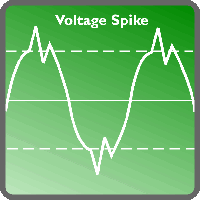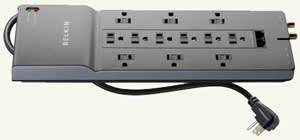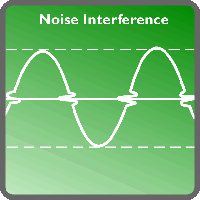
Figure 1 - Voltage spike
Surge protectors or surge suppression, the terms are interchangeable, protect our computers, appliances and other electronic and electrical equipment from electrical voltage spikes (Figure 1) that often appear on our electrical service, cable TV and telephone lines.
These electrical spikes can be caused by numerous events including lightening, utility brown-outs and the loading of your local power grid. They can and will damage electronic devices and appliances.
As with many devices, there are different quality levels of surge suppression or surge protection that you can purchase.
Following are the items that you should compare when shopping for a surge suppressor or surge protector:
Clamping Voltage:
The term clamping voltage defines the level of voltage that will activate the surge protection. The lower the clamping voltage number, the better the surge protection. Clamping voltages are usually one of 330, 400 and 500 volts. The best surge protection will be with a device that clamps the voltage at 330 volts.
Energy Rejection:
The surge protector or surge suppressor will have a rating that is in joules. It may state energy absorption or energy dissipation. This amount of joules of energy defines how much energy the surge suppressor of surge protector will absorb before it fails. A reasonable quality surge suppressor or surge protector will absorb a minimum of 500 joules. However, I recommend a minimum of 1,500 joules.
Response:
In electronics nothing is instantaneous, hence your electronic devices will see a spike until the surge suppressor or surge protector triggers its defensive circuitry. The best surge suppressors or surge protectors will respond to a spike in less than 1 nanosecond. Any time period longer than that exposes your delicate electronic equipment to spikes that may cause damage to their circuitry.
Working Indicator:
The electronic components in the surge protector or surge suppressor deteriorate every time they absorb an electrical spike. At some point, they will no longer function, yet the outlets that they should be protecting will be operational. A quality surge suppressor or surge protector will contain an indicator light of some sort that tells you if in fact the surge protection circuitry is functioning. Without an indicator of some sort you have no way of knowing if you are still protected from electrical spikes.
Guarantee:
The surge protectors’ guarantee is what separates the poor surge protectors from the good, better and best units. You want to buy a surge suppressor or surge protector that has a guarantee or warranty that provides reimbursement for the equipment that you are protecting, should the surge protector fail. This is usually specified a "Customer Equipment Warranty". Having a warranty or guarantee on the surge protector itself is little consolation if it fails and your $1,000 computer burns out! The "Customer Equipment Warranty" is also a good guideline for the overall quality of the surge protector as it puts the company on the line should their product fail. Look for a "Customer Equipment Warranty" of at least $50,000.

Figure 2 - Surge protection/suppression for electrical service, telephone lines, Ethernet and cable TV wiring
Infiltration:

Figure 3 - EMI & RFI interference
An energy spike can enter your electronic equipment through the electrical service, telephone lines, Ethernet and cable TV wiring. The better surge suppressors will also supply protection to these energy spike infiltration methods by providing input and output connections for standard cable TV and telephone lines, as shown in Figure 2.
Noise:
Your electronic devices can also be damaged from Electromagnetic Interference (EMI) and Radio Frequency Interference (RFI). The better surge suppressors or surge protectors will provide circuitry to protect against both EMI and RFI interference, as shown in Figure 3. This is especially important when using a surge suppression device to protect any audio related equipment.
Additional information on whole house surge suppression.
Selection of surge protection devices.
